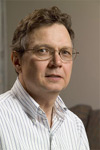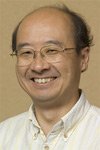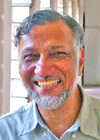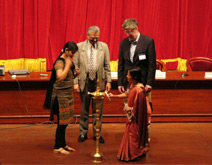 |
|
|
 |
GDE Boards Deliver Updates in Bangalore

Peter Garbincius, Chair of the Design Cost Board
|
Design and Cost Board
Peter Garbincius, chair of the GDE Design and Cost Board, presented their ongoing work. The Work Breakdown Structure (WBS) provides templates to each GDE working group and helps them define their cost estimates. "The main issues of this group is to make sure that the final system will be consistent and acceptable for everyone. ", said Garbincius. "In principle, the WBS we made should be applicable to every sub-system." The board will make sure each group identifies the major costs. Once the cost drivers are identified, the board will assess if they can be reduced. "Another issue is to encourage the group to provide the Change Control Board with a certain level of details on major items, to reduce uncertainty in the global machine cost", said Garbincius. To help them, the Design and Cost Board will provide a "recipe" for cost estimation.

Nobu Toge, Chair of the Change Control Board
|
Change Control Board
Nobu Toge, chair of the Change Control Board, presented the procedure for finalising the Baseline Configuration Document and integrating further changes. "We would like the group to provide us thorough descriptions of the reasons for the change request and risk assessment", Toge said. Whenever a change is required and made, the board will inform all affected groups. For every decision taken, the Change Control Board will make a public announcement. The board will also crosscheck all the statements given by the groups, to avoid inconsistency and accidental mistakes. “For this reason, we ask each group to submit the request with cross reference materials, if any. The more input we will have, the faster we could react and take decisions", Toge said. “The process seems to be in a good shape. So far I see no fundamental problem in running the Change Control Board."
Read more...
-- Perrine Royole-Degieux
|
 |
|
|
 |
|
 |
 |
|
|
 |
Hosting the LCWS06
Rohini Godbole of the Indian Institute of Science, who hosted the combined workshop of LCWS06 and the third Global Design Effort meeting, sees the value of combining the phenomenologists, theorists, experimentalists, accelerator physicists, and people from industry to come together in one place.
"I've been involved in linear collider physics since 1990," Godbole says. "Some work on hadron production in two photon reactions that we did at that time had interesting implications for the backgrounds in an e+e- collider and hence for design considerations for the linear collider. For me that was an interesting experience which had actual implications for what should be the bunches and sizes in the linear collider."
Godbole emphasizes that the uniqueness of this workshop is the joint meeting of the GDE and LCWS06. For her, this is an indication of the days to come. "More and more direct interactions between accelerator physicists, particle theorists and particle experimentalists are happening. All have to work simultaneously for the construction of this activity to be useful. To me, that's exciting as well as very challenging," she said.
India had several reasons for wanting to host the meeting at this time. "India has a very strong background in accelerator physics, and we have an equally strong background in detector physics," she said. "Indian industry has built magnets for LHC, and there is a lot of work on linac and superconducting cavities in India. In the LHC experiments, our scientists are setting up many of the analysis routines, and theorists and phenomenologists have been very hard working on this subject. My idea in this is that all these communities in India get together here to see how they can really contribute to ILC related programs. My feeling is because of this workshop, the Indian community will become more active in ILC related subjects. I'm hoping this would result in getting a higher participation from the Indian accelerator physics community and industry into this exercise."
Read more...
-- Youhei Morita
|
 |
|
|
 |
From The Hindu
10 March 2006
New device to understand mysteries of universe
Bangalore: An unusual machine now being developed through international scientific collaboration may answer questions about some of the deepest mysteries in the universe, such as what is the nature of mass, are there extra dimensions and what is the dark matter that makes up 95 per cent of the universe?
Read more...
From India Monitor
13 March 2006
US Lab seeks Indian hand in mega project
A team of over 20 scientists, mainly from US Department of Energy-funded Fermi Labs, Chicago, are trying to convince India to take a big lead in designing and building the International Linear Collidor, a giant project that would cost about $8 billion.
Read more... |
|
 |
 |
|
|
 |
Developing Partnership with India on the ILC

Dr. Vinod Sahni |
Last week, I discussed a set of visits to government officials in India with the purpose of laying the groundwork for Indian collaboration on the ILC. True collaboration is made between scientists, however, so the visits of our delegation to several of the major laboratories and institutions in India were just as important. Our delegation consisted of Jonathan Dorfan (SLAC Director), Albrecht Wagner (DESY Director), Pier Oddone (Fermilab Director), Bob Kephart (Fermilab), Shekhar Mishra (Fermilab) and Vinod Bharadwaj (SLAC), who met in different combinations with our Indian counterparts on the various visits.
India has an illustrious history in nuclear and particle physics. Their current particle physics program includes significant contributions to the Large Hadron Collider at CERN, including both accelerator and detector technologies. We also learned about a new commitment for accelerator R&D work being made for the CLIC R&D effort at CERN and an Indian initiative to build a large scale underground neutrino detector.
We visited the Department of Atomic Energy facilities at Indore and Mumbai, where we were hosted by Dr. Vinod Sahni, Director of the Raja Ramanna Centre for Advanced Technology (RRCAT). At RRCAT, we were shown Indus-2, a synchrotron radiation facility with electron energy of 2.5 GeV, as well as various technical support facilities. The accelerator is complete and in the process of being commissioned. It is a very impressive facility from the actual magnets and accelerator components to the control room and building housing the facility. Indus-2 is in the process of being commissioned and we visited their state of the art control room and control systems. We also visited Bhabha Atomic Research Centre (BARC) in Mumbai. Together, these two large laboratories have strong technical capabilities from design tools to machine shops to computer and software development.
Read more...
--Barry Barish
Director's Corner Archive
|
 |
|
|
 |
|
Live from Bangalore
Couldn't make it to the GDE meeting in Bangalore? Talks, images and summaries are available online.
More information |
|

Prof. Rohini Godbole, organizer of the LCWS06 and ILC GDE meeting,
declares the start of the workshop by lighting up a candle, as Anil
Kakodkar, Chairman of the Atomic Energy Commission and Secretary of
the Department of Atomic Energy in India, and Albrecht Wagner,
Director of DESY and new chairperson of ICFA closely watch by.
|
|

